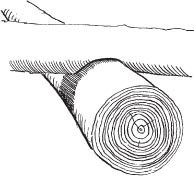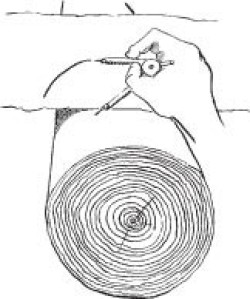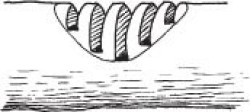If you’re considering building a log structure, you’ll need to learn to scribe logs. In most cases, you’ll be scribing for a saddle notch, used to join two logs perpendicularly, like at the corner of a cabin.
Fancy log scribes are available for $100 and up. They have levels to make sure you keep them plumb in all directions. If you are going to build a log home, these would be a good investment, but if you are looking to build a rougher building, where the logs won’t be prepped by sawing or hewing one or two faces flat, the expensive tools are overkill. Your not-really-straight and not-really-flat logs won’t fit perfectly no matter how expensive your scribe is.
You can do your scribing with a carpenter’s compass. It has all the requisite parts: namely, a point for tracing, a point for scribing, and an adjustable distance between the two so you can account for the desired depth of your cut, which is roughly half the diameter of the log you’re notching. If you go any deeper than that, you’ll have an unsightly gap at the top of the notch. Better to have the gaps between the logs and fill them with oakum or rope caulk.
Once you know the desired depth of the notch, set your compass at that distance. Place the log to be scribed exactly where you want it. If one end of the log will not be scribed, level it with blocks or shims to the height of your compass. Drive a Timberlock screw or two to keep the log in place as you scribe. Then, holding the compass as plumb as possible, follow the contours of the bottom log and scribe the top log, then go to the other side and repeat. Before you move the log, scribe the other end if you have another notch to cut there.
Once you’ve made all your scribing marks, unlock the log and flip it over. Carefully connect the scribe marks on each side so you know where to begin your cut. Then make vertical cuts with a chainsaw every half inch to the depth of the scribe marks and knock the wood out with a hammer. Clean the notch with a chisel or a chainsaw, flip it over again, and fit the log onto its new home.
Practice before you start with a real building – it takes a while to get the hang of scribing and cutting.





Discussion *